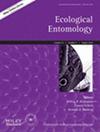Foraging for oviposition sites in the Hessian fly: random and non‐random aspects of movement
IF 1.6
3区 农林科学
Q2 ENTOMOLOGY
引用次数: 0
Abstract
黑森蝇的产卵地点觅食:运动的随机和非随机方面
对产卵的黑森蝇(双翅目:Cecidomyiidae)在植物阵列中的活动进行了量化,植物阵列有三种变化方式:(i) 寄主植物斑块之间的距离;(ii) 寄主植物斑块的大小;(iii) 非寄主植物阵列中寄主植物的密度。我们对一系列行为的持续时间和频率进行了量化,预计当寄主植物和非寄主植物的分布发生变化时,雌性会调整某些行为,但不一定是所有行为。当植物分布发生变化时,觅食行为会有所调整,这被视为非随机运动的证据(sensu Morris & Kareiva, 1991)。产卵雌虫也表现出对植物的定向反应;不过,定向反应似乎是基于草的一般视觉刺激,而不是特定物种的植物刺激(如气味)。当改变植物阵列时,一些行为参数没有变化。雌性在小麦斑块中停留的时间相对稳定,在离开小麦斑块前产卵的数量相似,与斑块中的植物数量或找到斑块所需的时间无关。非随机移动导致雌虫将卵产在寄主上而不是非寄主上,而随机移动则导致雌虫在更大的区域产卵。
本文章由计算机程序翻译,如有差异,请以英文原文为准。
求助全文
约1分钟内获得全文
求助全文
来源期刊

Ecological Entomology
生物-昆虫学
CiteScore
4.90
自引率
4.50%
发文量
94
审稿时长
3 months
期刊介绍:
Ecological Entomology publishes top-quality original research on the ecology of insects and related invertebrate taxa. Our aim is to publish papers that will be of considerable interest to the wide community of ecologists who are motivated by ecological or evolutionary theory. The suitability of a manuscript will usually be assessed within 5 days.
We publish full-length Original Articles as well as Reviews, Short Communications, Methods and Natural History papers. In Original Articles, we greatly prefer papers that test specific hypotheses and which have a high degree of novelty. All categories aim for innovative contributions that advance the subject of ecological entomology.
 求助内容:
求助内容: 应助结果提醒方式:
应助结果提醒方式:


